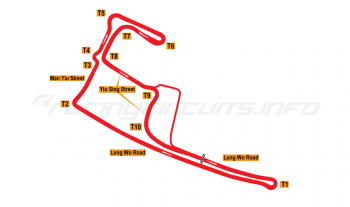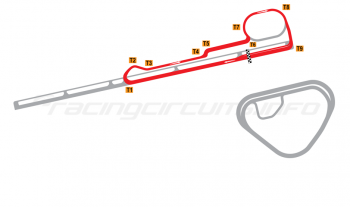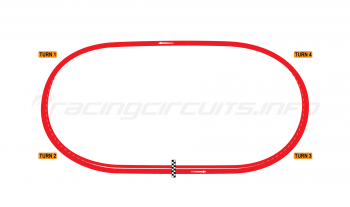Pittsburgh International Race Complex
Circuit Overview
Pittsburgh International Race Complex, more commonly referred to simply as ‘Pitt Race’, is a multi-discipline road course, hosting sports cars, formula cars, motorcycles and more.
The track originally opened in 2002 as BeaveRun Motorsports Park but was renamed after it was purchased in 2011 by Jim and Kathy Stout, who also now own Virginia International Raceway.
Since then, a course extension which had been planned since the track’s inception was completed, creating three track configurations, two of which can be run simultaneously. The Alan Wilson-penned facility makes the most of its hilly terrain to provide a rewarding and challenging drivers course, which has proved popular with amateur and professional racers alike.
Circuit History
Plans for a road racing course near in Beaver County, north of Pittsburgh, began in 1998 when local attorneys Tom Wettach and Tim Silbaugh met for the first time and discovered they had a shared passion for motorsport. Real estate attorney Silbaugh was a racing enthusiast and also a board member and counsel for the Pittsburgh Vintage Grand Prix Association, while Wettach was a self-confessed car guy, who worked as counsel for the Society of Automotive Engineers.
The pair decided that there was good potential for a racing facility to serve the area around Pittsburgh and beyond and began searching for partners and investors to make it a reality. Putting together a compelling business plan, over the next few years they formed the Speed4U limited partnership, attracting 40 individual equity investors and debt financing from the Employee Real Estate Investment Trust, a regional building trades pension fund.
What was next needed was a plot of land to locate their dream facility. The scenic rolling hills of Wampum, around 45 minutes north of Pittsburgh in Big Beaver Borough, seemed to provide the answer. Alongside its comic name potential, the area had a 384 acre plot near to a former strip mine that could be reclaimed for a different use. Featuring rolling terrain, it seemed to provide the perfect canvas for a circuit and the partnership soon purchased the plot and began planning for the new facility in earnest.
“One of the best decisions we made early on was to retain Alan Wilson, who has designed 16 of the country’s most successful racetracks, said Silbaugh. “Alan promised us that he’d talk us out of the project. Fortunately, he took one look at the terrain and the topography and immediately saw the potential for transforming it into a world-class motorsports complex.”
Circuit emerges in phases
Wilson penned a 2.780 mile road course, which would be built in two phases, with the northern portion coming first, and the adjoining southern loop being added as finances later allowed and the facility matured. From the outset, the plan was to make best use of the topography and create a course which would feature swooping elevation changes but provide a safe environment for amateur racers on two and four wheels.
“The BeaveRun site has significant elevations which make for great viewing and interesting riding and which have required a considerable amount of earth moving,” explained Wilson during the construction. “The consequence being that we have had to take extra care to plan necessary barriers where they need to protect from banks, drops and other features but in such a way that they will have the minimum impact potential.”
Construction broke ground in December 2001, with works continuing through 2002 to the opening of the road course in July. The 0.82 mile kart track and six-acre dry skid pad for driver train were completed by 2003, at a total cost of around $6.7 million.
Eating facilities, classrooms, restrooms and shower facilities were housed in 6,000 square feet of used modular buildings obtained from Slippery Rock University.
Course receives great acclaim
Into to its first year of operation, the new course proved popular, with track days, general testing and club events packing the calendar and leaving few dates without action taking place.
The undulating nature of the course provided plenty of challenge for drivers and riders, giving the feel of a twisty country road, rather than seeming like a purpose-built racing facility.
Among those to make use of the new circuit were engineers from Birdgestone/Firestone who tested new suspension systems and tyre products at BeaveRun.
The track also was quick to attract some of the major regional racing series, becoming the host to what was through t o be first professional road racing events staged in Western Pennsylvania in nearly 100 years. Sports car races sanction by the SCCA and NASA soon became the norm.
Expansion plans on hold before track is sold
In 2004, plans were announced for the project to complete the full facility through the addition of the south course. By 2005, additional new funding had been secured from Pennsylvania Governor Edward G. Rendell, who awarded BeaveRun with $100,000 towards the expansion plans. Further fundraising continued throughout the year but no groundworks had taken place.
In 2006, a pause on the plans were announced and the subsequent world financial turmoil dampened any prospects of the full course being completed. The track continued on as was, though the second-hand mobile buildings that had intended to be a stop-gap soon became something of a more permanent fixture as it became clear that cash was becoming tight.
The track soldiered on through the financial crisis, but by 2010 things had come to a head and the company began Chapter 7 bankruptcy proceedings. Two of the original investors, Kathy and Jim Stout, came forward as purchasers of the whole complex. Both accomplished Dodge Viper SRT racers, the pair embarked on a $6 million renovation programme.
Change of name begins revival
Among the first changes was a new name, literally with the aim of putting the track firmly on the map; Pittsburgh International Race Complex has the benefit of locating the track in people’s minds to its nearest major conurbation. The shorter ‘Pitt Race’ moniker has also proved very helpful in marketing terms.
In 2015, the south course became a reality, some 12 years after it was first planned. The additional 1.2 mile course can be run simultaneously and independent of the longer original course, though the pair are frequently combined to provide the longer 2.780 miles full course. Additional upgrade included a 12,000 square-foot event centre, while in 2017 a new timing and scoring building was added. Both tracks were also repaved at this time, removing many of the bumps that had been apparent from the original construction .
“There’s a 16in. deep concrete base beneath the track paving, which avoids it heaving and settling from the winter months,” explains Jim. “Once the paving was down, we drove it extensively to make sure we installed the apex curbing just where it needs to be.”
MotoAmerica arrives as facilities enhanced
The improvements have helped shore up the overall experience at the track and have also attracted interest from the motorcycle fraternity. A successful test by MotoAmerica riders in May 2017 led to the track being added to the championship calendar later that year, becoming a firm fixture thereafter. To accommodate the higher speeds of the Superbike racers, a new chicane was added as part of the 2017 repave, ahead of the sweeping Turn 16 of the full course (Turn 9 of the North Course).
Series veteran and privateer Superbike racer Kyle Wyman helped create the chicane. “The track already moved the wall once, and they can’t move it any farther because there is a cliff behind it,” he told Cycle World magazine. “If something went wrong, we were going at a pretty good clip. MotoAmerica drafted a couple of ideas for a chicane, and it was my job to mock up different options.”
Riding a stock Yamaha R1 on an empty track, Wyman tried out various temporary configurations, though when landscape, drainage and space limitations were taken into account, only one proved viable. A patch of asphalt was laid to enable a second gear chicane to be added on the approach to Turn 16, with temporary rubber kerbing employed for the visits of the MotoAmerica classes. All other events run the original layout of the course, though benefit from the increased run-off provided.
Today Pitt Race continued to hosted numerous regional and national events, including NASA and SCCA, alongside the annual visit of MotoAmerica, plus general testing, a Superbike school, track days and promotional events, which mean it sees action most days of the week.
Jump onboard
Circuit info
- Pittsburgh International Race Complex, 201 Penndale Road, Wampum, PA 16157, USA
- +17245351000
- Email the circuit
- Official website
Rate This Circuit
Votes: 554
Plan a visit
Get your race tickets!
Brought to you with: 
We've teamed up with Motorsports Tickets to bring you the best deals for Formula One, MotoGP, Le Mans and more.

















